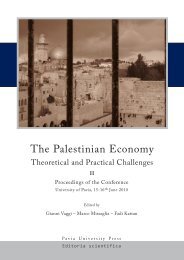Musica che affronta il silenzio - Scritti su Toru Takemitsu - Pavia ...
Musica che affronta il silenzio - Scritti su Toru Takemitsu - Pavia ...
Musica che affronta il silenzio - Scritti su Toru Takemitsu - Pavia ...
You also want an ePaper? Increase the reach of your titles
YUMPU automatically turns print PDFs into web optimized ePapers that Google loves.
162<br />
Angela Ida De Benedictis<br />
During the occupation in the immediate post-war years the American army set up the<br />
Center for Information and Education in Tokyo. In a chapter of his ‘Contemporary Music<br />
in Japan’ Takemit<strong>su</strong> told how he often used to go there in the late 1940s in order to study<br />
the scores of music composed in America (1989a). Moreover he was able to listen to a lot<br />
of that music thanks to an American radio station, the WVTR. The composers he mentions<br />
are Roy Harris, Aaron Copland, Walter Piston, Roger Sessions and George Gershwin, and<br />
he tells how he gradually came ‘to develop a sense of my own musical taste’. 6 Among the<br />
works he listened to at that time – all of them representing something ‘rare, unknown, so<br />
wonderful’ – it was precisely the music of Copland which made a particular impression: ‘I<br />
loved Aaron Copland’s Violin Sonata. I thought at that time, oh, this is American Mozart –<br />
very simple, but very well done. I knew American music first, before I knew Schoenberg or<br />
Webern, because, after the war, we had no way of hearing new music’ (Takemit<strong>su</strong> 1989b:<br />
207). 7 The name of Anton Webern takes us back to the Second Viennese School, which<br />
Takemit<strong>su</strong> explored in the so-called ‘second phase’ of his career, coinciding with his return<br />
to or discovery of traditional Japanese music. 8 It is st<strong>il</strong>l not clear exactly when Takemit<strong>su</strong><br />
first came into contact with Webern’s output. 9 What we can say for certain is that the use of<br />
contrapuntal forms and mirroring devices – clearly deriving from Webern – characterises a<br />
large part of the compositions written in the period going from 1957 up unt<strong>il</strong> Piano Distance<br />
in 1961 and Arc in 1963. However, his interest in the Second Viennese School seems<br />
to have stopped at the formal aspect: he categorically rejected its structural organization of<br />
pit<strong>che</strong>s according to the dodecaphonic system. In 1971 he even went so far as to declare:<br />
The twelve-tone method of composition may be the re<strong>su</strong>lt of historical necessity, but<br />
it presents some very dangerous aspects. The mathematical and geometric pur<strong>su</strong>it of<br />
sound apparent in this technique is purely an intellectual act. It can re<strong>su</strong>lt in the<br />
same weaknesses as those that arise in any overspecialized aesthetic purity. It carries<br />
with it the danger of hardening perceptions, and it is the perceptions that are the basic<br />
elements in creativity. (Takemit<strong>su</strong> 1995a: 80)<br />
This is undoubtedly an important assertion, and yet it reveals a profound mi<strong>su</strong>nderstanding<br />
of the dodecaphonic method which would require a much more thoroughgoing<br />
consideration than is possible here.<br />
6 Cf. Takemit<strong>su</strong> (1989a: 200). For the names of the composers mentioned cf. also Takemit<strong>su</strong> (1989b: 207).<br />
7 In the same conversation Takemit<strong>su</strong> also makes the significant statement that his idea of European music<br />
was indeed mediated by American culture.<br />
8 On the ‘phases’ of Takemit<strong>su</strong>’s artistic biography see Miyamoto (1996) and Burt (2001).<br />
9 In the conversation with Cronin and Tann (cf. note 7) Takemit<strong>su</strong> (1989b: 207) stated generically ‘I was very<br />
influenced by the Viennese School, and also by Debussy’, without giving any specific dates or titles. We<br />
should bear in mind that immediately after the War Yorit<strong>su</strong>ne Mat<strong>su</strong>daira had been one of the first in Japan to<br />
introduce into his own music elements of the twelve tone method, effecting a hybrid with the musical theory<br />
of the gagaku (cf. Bekku 1961: 95).

















